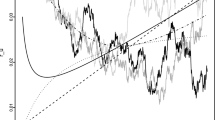Abstract
We prove an Itô–Tanaka formula and existence of pathwise stochastic integrals for a wide class of Gaussian processes. Motivated by financial applications, we define the stochastic integrals as forward-type pathwise integrals introduced by Föllmer and as pathwise generalized Lebesgue–Stieltjes integrals introduced by Zähle. As an application, we illustrate the importance of the Itô–Tanaka formula for pricing and hedging of financial derivatives.
Similar content being viewed by others
References
Azmoodeh, E.: Riemann-Stieltjes Integrals with Respect to Fractional Brownian Motion and Applications. PhD Thesis. Helsinki University of Technology Institute of Mathematic s Research Reports A590 (2010)
Azmoodeh, E., Mishura, Y., Valkeila, E.: On hedging European options in geometric fractional Brownian motion market model. Stat. Decis. 27, 129–143 (2010)
Azmoodeh, E., Viitasaari, L.: Rate of convergence for discretization of integrals with respect to fractional Brownian motion. J. Theor. Probab. (2013). doi:10.1007/s10959-013-0495-y
Bender, C., Sottinen, T., Valkeila, E.: Arbitrage with fractional Brownian motion? Theory Stoch. Process. 13(29), 23–27 (2007)
Bender, C., Sottinen, T., Valkeila, E.: Pricing by hedging and no-arbitrage beyond semimartingales. Financ. Stoch. 12, 441–468 (2008)
Berman, S.M.: Local nondeterminism and local times of gaussian processes. Indiana Univ. Math. J. 23, 69–94 (1973)
Bertoin, J.: Temps locaux et intégration stochastique pour les processus de dirichlet. Séminaire de Probabilités 21, 191–205 (1987)
Coutin, L., Nualart, D., Tudor, C.: Tanaka formula for the fractional Brownian motion. Stoch. Process. Appl. 94(2), 301–315 (2001)
Föllmer, H.: Calcul d’ito sans probabilités. Séminaire de Probabilités 15, 143–150 (1981)
Nualart, D., Răşcanu, A.: Differential equations driven by fractional Brownian motion. Collect. Math. 53, 55–81 (2002)
Revuz, D., Yor, M.: Continuous Martingales and Brownian Motion. Springer, Berlin (1999)
Samko, S.G., Kilbas, A.A., Marichev, O.I.: Fractional Integrals and Derivatives, Theory and Applications. Gordon and Breach Science Publishers, Yvendon (1993)
Sondermann, D.: Introduction to Stochastic Calculus for Finance: A New Didactic Approach. Springer, Berlin (2006)
Sottinen, T., Valkeila, E.: On arbitrage and replication in the fractional Black–Scholes pricing model. Stat. Decis. 21, 93–107 (2003)
Young, L.C.: An inequality of the hölder type, connected with Stieltjes integration. Acta Math. 67, 251–282 (1936)
Zähle, M.: Integration with respect to fractal functions and stochastic calculus. Part I. Probab. Theory Relat. Fields 111, 333–372 (1998)
Author information
Authors and Affiliations
Corresponding author
Additional information
L. Viitasaari was financed by the Finnish Doctoral Programme in Stochastics and Statistics.
Appendix: Level-Crossing Lemma
Appendix: Level-Crossing Lemma
The key lemma in our analysis is the following estimate for the probability that a Gaussian process \(X\) crosses a fixed level. Actually, in [3] the authors proved the lemma in the particular case of fractional Brownian motion. We extend the result here for more general Gaussian process. We consider only probability \({\mathbb {P}}(X_s < a < X_t)\) and a case \(\sup _{s\le T} V(s) \le 1\). However, by considering processes \(Y = -X\) and \(Y = \frac{X}{\sqrt{V^*}}\) we obtain same bound for \({\mathbb {P}}(X_s > a > X_t)\) and for the general case \(\sup _{s\le T} V(s) < \infty \). Also, note that continuous Gaussian processes on compact time intervals satisfy \(V^*<\infty \).
Lemma 4.1
Let \(X\) be a Gaussian process with positive covariance function \(R\). Denote
and fix \(0 < s < t \le T\) and \( a \in {\mathbb {R}}\). Assume that the variance function satisfies
-
(i)
If
$$\begin{aligned} \frac{R(s,s)}{R(t,s)}(a-1) < a, \end{aligned}$$then there exists a constant \(C\), independent of \(s\), \(t\), \(T\) and \(a\), such that
$$\begin{aligned} {\mathbb {P}}\big ( X_s < a < X_t\big ) \le I_1 + I_2 + I_3 +I_4, \end{aligned}$$where
$$\begin{aligned} I_1&\le C \min [\sqrt{V(s)}\sigma ,\sigma ^2] e^{-\frac{a^2}{2}}, \\ I_2&\le Ce^{-\frac{\min [a^2,(a-1)^2]}{2V^*}}\frac{\sigma }{\sqrt{V(s)}}\left[ {\mathbf {1}}_{|a|>2}+\left( a-\frac{R(s,s)}{R(t,s)}(a-1)\right) {\mathbf {1}}_{|a|\le 2}\right] , \\ I_3&\le C \frac{R(s,s)}{R(t,s)}\frac{\sigma }{\sqrt{V(s)}}e^{-\frac{\min [a^2,(a-1)^2]}{2V^*}}, \\ I_4&\le e^{-\frac{a^2}{2V^*}}\frac{1}{\sqrt{V(s)}}\left| a\left( 1-\frac{R(s,s)}{R(t,s)}\right) \right| , \end{aligned}$$ -
(ii)
If
$$\begin{aligned} \frac{R(s,s)}{R(t,s)}(a-1) \ge a, \end{aligned}$$then there exists a constant \(C\), independent of \(s\), \(t\), \(T\) and \(a\), such that
$$\begin{aligned} {\mathbb {P}}\big ( X_s < a <X_t \big ) \le C \min [\sqrt{V(s)}\sigma ,\sigma ^2] e^{-\frac{a^2}{2}}. \end{aligned}$$
In the proof we use the following well-known estimate.
Lemma 4.2
Let \(Z\) be a standard normal random variable and fix \(a>0\). Then
Proof of Lemma 4.1
We make use of decomposition
where \(Y\) is \(N(0,1)\) random variable independent of \(X_s\) and
Assume that
Then we obtain
Moreover, if
then
Note that here \(I_1\) corresponds the one given in the Lemma and \(A_1\) contains \(I_2\), \(I_3\) and \(I_4\). We shall use similar technique for the rest of the proof.
We begin with \(I_1\). By Lemma 4.2 we have
where \(A(x) = \frac{a-\frac{R(t,s)}{R(s,s)}x}{\sigma }\). Hence
We proceed to study the integral. Now,
where
Now
and since \(V^*\le 1\), we also have
Thus,
Hence, we obtain for \(I_1\) that
Now we have
and hence for \(I_1\) there exists a constant \(C\) such that
For the term \(A_1\) we have
Consider then \(I_2\). Applying Lemma 4.2 we obtain
Note that \(\sigma ^2\ge 0\). Therefore,
Now if \(|a|> 2\), we can apply Lemma 4.2 to obtain
As a consequence, we obtain the required upper bound for \(I_2\). Now, if \(|a| \le 2\) we obtain
To conclude we study the term \(A_2\). If we have
then by applying the Tonelli theorem we obtain
Moreover, if
then
Now, for \(I_3\) we have
Hence, we have the required upper bound for \(I_3\). To conclude, note that for \(I_4\) we have
This finishes the proof of Lemma 4.1. \(\square \)
Rights and permissions
About this article
Cite this article
Sottinen, T., Viitasaari, L. Pathwise Integrals and Itô–Tanaka Formula for Gaussian Processes. J Theor Probab 29, 590–616 (2016). https://doi.org/10.1007/s10959-014-0588-2
Received:
Revised:
Published:
Issue Date:
DOI: https://doi.org/10.1007/s10959-014-0588-2
Keywords
- Föllmer integral
- Gaussian processes
- Generalized Lebesgue–Stieltjes integral
- Itô–Tanaka formula
- Mathematical finance
- Pathwise stochastic integral




